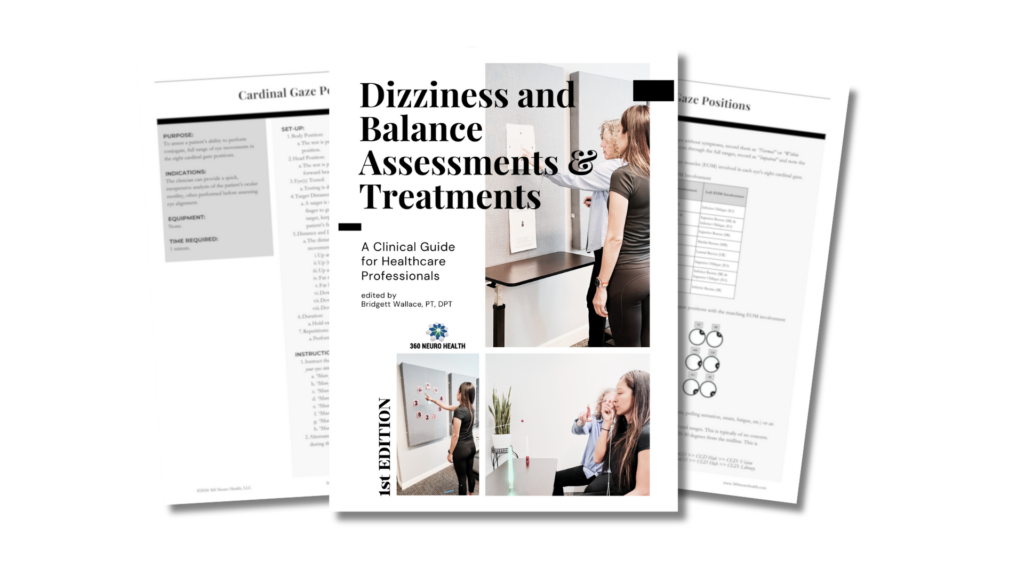Why Does the 8-Cardinal Gaze Test Matter

PURPOSE:
To assess a patient’s ability to perform conjugate, full range of eye movements in the eight cardinal gaze positions.
INDICATIONS:
The clinician can provide a quick, inexpensive analysis of the patient’s ocular motility, often performed before assessing eye alignment.
EQUIPMENT:
None.
TIME REQUIRED:
1 minute.
SET-UP:
- Body Position:
- The test is performed with the patient sitting in an upright position.
- Head Position:
- The test is performed with the head in a neutral position. Avoid forward head posture or head tilt as much as possible.
- Eye(s) Tested:
- Testing is done binocularly (using both eyes).
- Target Distance:
- A target is not required, but the examiner can use their index finger to guide the directions. If using your index finger as a target, keep the target 18 inches (46 centimeters) from the patient’s face.
- Distance and Direction of Path:
- The distance will be to their end range of available eye movements and the path direction as follows:
- Up and far right
- Up (toward the ceiling)
- Up and far left
- Far right
- Far left
- Down and far right
- Down (toward the floor)
- Down and far left
- The distance will be to their end range of available eye movements and the path direction as follows:
- Duration:
- Hold each position 2 seconds.
- Repetitions:
- Perform 1 repetition in each direction.
INSTRUCTIONS:
- Instruct the patient, “You will keep your head still while I ask you to move your eyes into eight different positions.”
- “Move your eyes up and to the right as far as you can.”
- “Move your eyes up toward the ceiling.”
- “Move your eyes up and to the left as far as you can.”
- “Move your eyes as far right as you can.”
- “Move your eyes as far left as you can.”
- “Move your eyes down and to the right as far as you can.”
- “Move your eyes down toward the floor.”
- “Move your eyes down and to the left as far as you can.”
- Alternate between observing the left and right eye in each gaze during the exam.
THE VALUE:
The 8-Cardinal Gaze Test is an ocular motility exam that holds immense value in assessing the overall health and function of the eye. It involves testing the six extraocular muscles that work together to control the movement of our eyes in multiple directions – up/down, left/right, and diagonally in all four quadrants. These six muscles have a unique and complex relationship, acting as both agonists and antagonists to achieve precise eye movements. The extraocular muscles have the highest ratio of motor neurons to muscle fibers in the body, allowing for incredible fine motor control and perfect alignment of the eyes. The 8-cardinal gaze test is crucial in diagnosing various eye conditions such as strabismus (eye misalignment), nystagmus (involuntary eye movements), and cranial nerve palsy (damage to the nerves controlling eye movements). It can also provide insight into underlying neurological conditions. The findings of this test can also be used as ocular motility exercises to enhance visual performance and address symptoms related to daily visual tasks.
CLINICAL TAKEAWAYS:
- In CN III palsy (oculomotor nerve), ocular motility can be impaired in multiple directions due to multiple innervations (medial rectus, superior rectus, inferior rectus, and inferior oblique. CN III palsy usually includes a droopy eyelid (ptosis) and dilation of the pupil (mydriasis). In center gaze, the affected eye is positioned outward (exotropia) due to medial rectus impairment and downward (hypotropia) due to lack of opposition from the superior rectus.
- In CN III palsy, the exotropia worsens with contralateral gaze and upward gaze. The patient may also report vertical double vision (diplopia) and convergence is impaired on the affected side to medial rectus involvement.
- In CN IV palsy (trochlear nerve), the superior oblique muscle is affected, resulting in hypertropia of the affected eye. The impairment may be too subtle to identify in center gaze but worsens in contralateral downward gaze (e.g., looking downward away from the affected side) and ipsilateral head tilt (e.g., tilting the head to the same side).
- The findings associated with CN IV palsy must be differentiated from a pathological ocular tilt response (OTR), which results in a 1) head tilt toward the affected side, 2) a skew deviation (vertical misalignment), and 3) a torsion of both eyes towards the hypotropic eye (excyclotorsion of the affected side and incyclotorsion on the contralateral side). This requires more testing beyond the 8-cardinal gaze test, such as observing ocular alignment with head tilt, comparing findings in seated versus supine position, and using a Maddox Rod.
- In CN VI (abducens nerve), the affected eye is positioned inward (esotropia) due to lateral rectus impairment and worsens in lateral gaze to the affected side.
- Keep in mind…ocular nerve palsies also mimic other disorders, such as Myasthenia Gravis (MG), posterior communicating artery aneurysm (PCOM), and brainstem or cerebellar lesions.
VIDEO DEMONSTRATION:
For interpretation and additional considerations, grab your copy of the Dizziness and Balance Assessments & Treatments – A Clinical Guide for Healthcare Professionals | 1st Edition today! Click here to learn more.